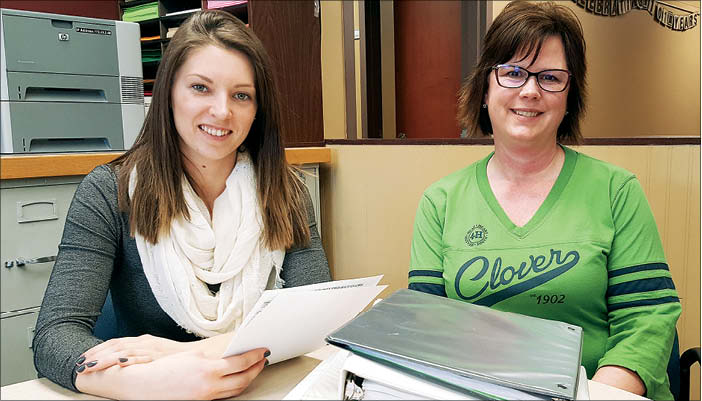4-H has come a long, long way since it sank its largely rural roots into the Minnesota countryside. Launched 115 years ago in Douglas County, the University of Minnesota Extension Service program has evolved along with the increasingly urban youth it serves.
The cooking, calves and crops that long enthralled young 4-Hers here in Clay County have broadened in decidedly modern directions. Now project groups focus on an array of non-traditional pursuits – underwater robots, Lego engineering challenges, the care and culture of pets. After-school programs in many schools offer fun weekly experiences in STEM-oriented subjects (science, technology, engineering and math). Six-week 4-H Summer Adventures draw vacationing kids to take part in entertaining activities at local schools, in Moorhead parks, during Migrant School and at Churches United. About 85 take part during the school year; the summer programming reaches about 230.
And then there are traditional clubs – 11 of them with some 400 members, based in Barnesville (the largest) to every other corner of Clay County. Their members lead the local clubs, most meeting monthly. They now follow their own interests to a far wider range of interests than the farm-oriented 4-H founders could have imagined – beef, but also bicycles; clothing and textiles, but computers too; dogs and cats as well as goats, horses and alpaca; and fishing, shooting sports and wildlife biology.
It’s all about keeping 4-H mission’s vigorous and alive, say Mitzi Marlin and Lisa Kasson-Bauer, the two Extension Service staffers who work with Clay County youth. Headquartered in the Family Service Center across from the Clay County Courthouse, they work with parent volunteers and the youth themselves to shape a program that appeals to kids in Barnesville, Moorhead, the Sabin/Baker/Rustad area, Georgetown/Kragnes, Ulen/Hitterdal, Glyndon/Felton/Dilworth and Hawley.
“If we’d just stayed with the traditional community clubs, our numberswould probably be dropped,” says Mitzi, who concentrates on those groups as well as overall leadership and planning tasks shared by youth and adult volunteers. “We’re competing now with all kinds of sports, band and other activities.” At the same time, she notes, population – and membership – has shifted from primarily farm families toward more who live in town.
“That’s why we’ve also taken our programs to where the kids are,” her colleague Lisa adds. She’s in charge of after-school and summer groups and the county’s four special-interest clubs. “We couldn’t stay back in the ’80s and survive. Our numbers are on the way back up, holding steady or slowly growing.”
Mitzi – a horse-loving former 4-Her who grew up in Anoka County and attended the University of Minnesota at Crookston – explains that training young people to lead has been, and remains, a central part of 4-H clubs’ mission. “We say 4-H is ‘youth-led and adult-guided.’ Our focus has changed from the perfect cookie and top show animal to overall youth development, with social and emotional learning and 21st century skills. We’re all about developing the whole person.”
The Clay County 4-H organization has earned acclaim in several areas – some traditional, like its excellent horse program, plus others that seem more unlikely. One is Aquatic Robotics, in which teens have built and modified ROVE robots armed with cameras and guided by computer – potentially useful for tasks from measuring water quality to hunting for zebra mussels. The team has made presentations to the Clay County Commission, the national 4-H convention and Minnesota’s Friends of Extension gatherings.
Groups of 9- through 14-year-olds take part in two Lego competitions, the First Lego League and Lego Warriors. The Awesome Pawsome group focuses on cats, dogs and other small animals, meeting monthly at the Moorhead Library.
Lisa, who moved from southwest Nebraska to Clay County 20 years ago when her husband joined the NDSU Animal Science faculty, has developed after-school and summer curricula built around intriguing STEM themes. Among them: this summer’s sessions titled “What Goes Up Must Come Down.” Centered on the study of gravity, lessons revolve around hands-on activities building catapults, experimenting with gliders, conducting an egg drop and exploring the physics of parachutes.
Mitzi says another of the county’s most recognized achievements has been its leadership development programs. 4-H members handle many of the functions of running the Clay County Fair, coming up July 13-16. “The youth leadership teams handle what would otherwise require at least two full-time adult employees,” Lisa explains. They train together, then handle the entire 4-H portion of the annual get-together, from announcing livestock and fashion shows to managing the popular 4-H food booth.
One responsibility is aiding in the judging. 4-H exhibits and animals are rated using a method that’s new to 4-H veterans from the old days. Called “conference judging,” it focuses not only on the exhibit the member has entered, but also the exhibitor’s knowledge and understanding. Other team members set up and run audio systems; manage club volunteers working in the food booth; and report on the action through posts on social media.
Those who enter 4-H exhibits are rated according to what 4-Hers call “conference judging” – not only a review of the project that has been entered, but conversation with the young man or woman who brought it. Ribbons are awarded, not only based on the entry’s perfection, but the entrant’s understanding and ability to express what he or she has learned.
The same approach keeps the focus on learning in all the self-directed projects pursued back in the club setting. “Reflections are part of all our activities,” Lisa says of the final step in every project. “We teach members to lead discussions themselves. ‘What have you learned? How will you use this?’ It’s all part of keeping them engaged in learning and leading.”
4-H programs and clubs are open to all Clay County students from kindergarten through high school. Information on after-school and summer programs is available through local community education calendars. You can find more information online at www3.extension.umn.edu/county/clay/4-h



